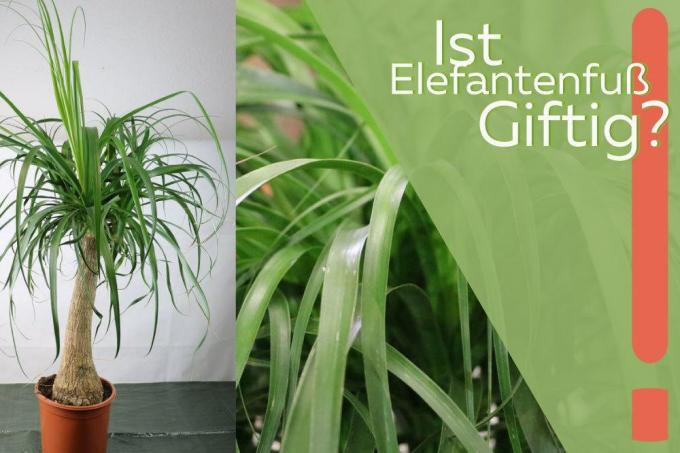
table of contents
- Elephant foot
- Likelihood of confusion
- Toxicity
- For the people
- For pets
- First aid measures
The elephant foot, also called the elephant tree, with its long, thin, drooping leaves is one easy-care houseplant that can grow up to nine meters high in its native Mexico in the wild can. The succulent tree has the botanical name Beaucarnea recurvata and belongs to the asparagus family (Asparagaceae).
Elephant foot
Beaucarnea recurvata is poisonous in all parts of the plant. The toxins contained are saponins. The Elephant foot classified as slightly poisonous, therefore the plant is not suitable for consumption, neither for humans nor Animal.

Likelihood of confusion
From a botanical point of view, there is no danger of confusion, but the plant is occasionally used under the name Bottle tree offered. Since the real bottle tree is non-toxic, if in doubt you should refer to the botanical name of the bottle tree "Brachychiton rupestris" when buying the non-toxic plant.
Toxicity
For the people
"Slightly toxic" means for adults that Symptoms of poisoning show only after consuming very large quantities of the plant. In the case of children, however, it looks different. Since they are smaller than adults and weigh less, symptoms of poisoning can show up even when consuming small amounts. As with all poisons, the smaller the child and the faster the poisoning sets in.
Tip: Households with children do not have to do without the elephant foot, but it should be placed out of the reach of children.
Symptoms of poisoning
If children have nibbled from the elephant tree, the following symptoms of poisoning can occur.
- malaise
- dizziness
- nausea
- sudden tiredness
- stomach pain
- Visual disturbances
- Vomiting (vomiting blood)
If the sap of the elephant tree comes into contact with the skin or with open wounds, severe, even purulent, inflammations are possible.

Tip: To prevent the saponins from getting into the blood, you should always wear gloves when working with the plant, because the leaves have sharp edges that can easily scratch the skin.
For pets
As for humans, the elephant foot is also poisonous for pets, so if it is desired as a houseplant, it should Be out of the reach of pets, especially dogs and cats, as the saponins irritate the animals' mucous membranes.
dogs and cats
Cat owners know: The lively house tigers are extremely curious companions. That is why they like to play with the thin leaves of the elephant tree, especially when the leaves are one meter or more long. If the cat shows interest in the elephant's foot, it is better to remove the houseplant, as the consumption of the leaves leads to gastroenteritis and chronic intestinal inflammation in the four-legged friends.
Tip: If the cat shows no interest in the elephant tree, you should still place the plant out of the reach of your favorite, because the tide can turn quickly with cats.

It is not clear whether the elephant tree poses a danger to dogs. What is certain, however, is that the mucous membranes of dogs and especially puppies are irritated by snacking on the elephant's foot.
Other pets
Since the saponins in the elephant tree irritate the mucous membranes of animals, it is not suitable as a houseplant for households with pets that feed on plants. Bird owners should also think twice about buying an elephant's foot, as they too can consider the long, thin leaves as toys.
First aid measures
Measures in the event of symptoms of intoxication
Have children If you eat leaves or parts of leaves of the elephant tree, you should consult a doctor with the child or the competent person Poison Control call. Never give the child milk to drink or make them vomit. If the sap of Beaucarnea recurvata got into an open wound, you should rinse it out under running water. However, this is only a first measure, if the wound becomes infected, you should definitely consult a doctor. If your darling has nibbled on the plant, you should get one right away vet to seek out.




